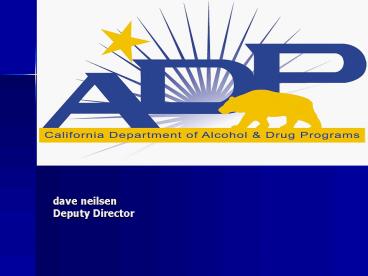dave neilsen Deputy Director - PowerPoint PPT Presentation
1 / 13
Title:
dave neilsen Deputy Director
Description:
SAMHSA provides state incentive grants to states using the DDCAT. SAMHSA views the DDCAT as an instrument that fosters integrated services for ... – PowerPoint PPT presentation
Number of Views:39
Avg rating:3.0/5.0
Title: dave neilsen Deputy Director
1
dave neilsenDeputy Director
2
Commitment, Knowledge and Services
- The Department of Alcohol and Drug Programs (ADP)
is committed to providing excellent quality care
and services to our clients with Co-Occurring
Disorders (COD). - As a former provider, Director Zito knows it is
critical that providers are able to serve our
clients that walk through the treatment door.
3
State of Affairs ADP, the Department of Mental
Health and the Co-Occurring Joint Action
Councils (COJAC) Collaboration has lead to
progress in COD treatment
- COJAC Screening Sub-Committee developed a simple
instrument designed to assist substance abuse and
mental health providers screen for clients in
need of further assessment of COD. - The instrument contains nine questions
- Requires very little time to administer
- Minimal staff training and can be used in a wide
variety of settings
4
Validation of COJAC Screener
- ADP is sponsoring and conducting a scientific
study designed to establish the validity of the
COJAC screening instrument. - The duration of the study is two years.
- Once validated, one possible next step is
- Adoption of this instrument throughout
California. - The use of this instrument will ensure that
those with COD are identified and served at every
point of entry because there should be no wrong
door.
5
Use of the Dual Diagnosis Capability Assessment
Tool (DDCAT) to Assess Treatment Providers COD
Services in the following Areas
- I. Programs Environment
- II. Clinical Process Assessment
- III. Clinical Process Treatment
- IV. Continuity of Care
- V. Program Structure
- VI. Staffing
- VII. Training
6
Benefits of the DDCAT
- User friendly
- Concrete
- Identifies strengths in programs
- Identifies specific avenues for change
- Develops a baseline for development of action
plans to advance dual diagnosis capability
7
Endorsed by the Substance Abuse and Mental Health
Services Administration (SAMHSA)
- SAMHSA provides state incentive grants to states
using the DDCAT - SAMHSA views the DDCAT as an instrument that
fosters integrated services for persons with
co-occurring mental and addictive disorders - SAMHSA endorses the DDCAT as an assessment tool
that may be used to determine effectiveness of
programs providing integrated treatment services - Currently, 20 other states are using this
instrument in similar efforts
8
ADPs Pilot of the DDCAT
- ADPs Pilot involves administering and validating
the scores of the DDCAT instrument among 3
southern and - 3 northern California providers.
- This effort will help the state and substance
abuse providers determine their capability for
treating COD - A first step in identifying which providers are
delivering effective treatment and what program
areas can be improved upon - Helps inform the field to move towards standards
in care for COD programs
9
Opportunities within the Mental Health Services
Act (MHSA)
- The MHSA, Prevention and Early Intervention (PEI)
component, provides a unique opportunity to
accomplish some of this work. - The PEI allows substance abuse providers to
participate locally by offering programs for
individuals who are at risk of developing a
serious mental illness or for those whose
substance abuse treatment would prevent the
worsening of a mental illness.
10
DDCAT ON THE WEB
- The DDCAT (14 pages) is available for download at
the following location - http//www.smilevermont.com/mh/visi/documents/DDCA
T_fidelity_scale.pdf - An introductory manual (40 pages)
- http//www.smilevermont.com/mh/visi/documents/DDCA
T_introductory_manual.pdf - An explanatory computer slide show (67 pages)
- http//coce.samhsa.gov/cod_resources/PDF/DDCATIntr
oVersion23.pdf - A Dual Diagnosis Capability in Addiction
Treatment Toolkit (127 pages) - http//www.smilevermont.com/mh/visi/documents/DDCA
T_Toolkit.pdf
11
PEI Strategies
- ADPs COD Unit staff developed and disseminated
several strategies to substance abuse providers. - Providers can use in collaboration with their
counties, for the provision of services, when
consistent with local PEI priority activities.
12
Strategies for Substance Abuse in
- Student Assistance Programs
- Youth Development
- Mentoring Programs
- Drug Court and Proposition 36 Support Programs
- Hiring of Mental Health Staff at Alcohol and
Other Drug Treatment Programs No Wrong Door - Family Counseling for Domestic Violence Clients
and Family Members - Suicide Prevention
13
For More Information
- The Co-Occurring Joint Action Council
- www.adp.ca.gov/cojac/index.shtml
- The Department of Alcohol and Drug Programs
- www.adp.ca.gov/COD/index.shtml
- The Co-Occurring Disorders Unit
- CODUnit_at_adp.ca.gov































